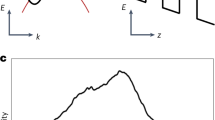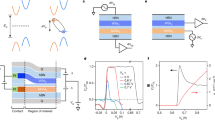Abstract
Among the many examples of Bose condensation considered in physics, electron–hole-pair (exciton) condensation has maintained special interest because of controversy about condensate properties. Although ideal condensates can support an exciton supercurrent, it has not been clear how such a current could be induced or detected. This paper addresses the electrical generation of exciton supercurrents in bilayer condensates (systems in which the electrons and holes are in separate layers) and reaches a surprising conclusion. We find that steady-state dissipationless currents cannot be induced simply by connecting the two layers in series to guarantee opposite currents in electron and hole layers, as has long been supposed. Instead, current should be injected into and removed from the same layer, and a conducting channel supplied to close the counterflow portion of supercurrent in the other layer.
This is a preview of subscription content, access via your institution
Access options
Subscribe to this journal
Receive 12 print issues and online access
$209.00 per year
only $17.42 per issue
Buy this article
- Purchase on Springer Link
- Instant access to full article PDF
Prices may be subject to local taxes which are calculated during checkout



Similar content being viewed by others
References
Spielman, I. B., Eisenstein, J. P., Pfeiffer, L. N. & West, K. W. Resonantly enhanced tunneling in a double layer quantum Hall ferromagnet. Phys. Rev. Lett. 84, 5808–5811 (2000).
Spielman, I. B., Eisenstein, J. P., Pfeiffer, L. N. & West, K. W. Observation of a linearly dispersing collective mode in a quantum Hall ferromagnet. Phys. Rev. Lett. 87, 036803 (2001).
Tiemann, L. et al. Exciton condensate at a total filling factor of one in Corbino two-dimensional electron bilayers. Phys. Rev. B 77, 033306 (2008).
Tiemann, L. et al. Critical tunneling currents in the regime of bilayerexcitons. New J. Phys. 10, 045018 (2008).
Wiersma, R. D. et al. Activated transport in the separate layers that form the νT=1 exciton. Phys. Rev. Lett. 93, 266805 (2004).
Tutuc, E., Shayegan, M. & Huse, D. A. Counterflow measurements in strongly correlated GaAs hole bilayers: Evidence for electron–hole pairing. Phys. Rev. Lett. 93, 036802 (2004).
Blatt, J. M., Böer, K. W. & Brandt, W. Bose–Einstein condensation of excitons. Phys. Rev. 126, 1691–1692 (1962).
Moon, K. et al. Spontaneous inter-layer coherence in double-layer quantum Hall systems: Charged vortices and Kosterlitz–Thouless phase transitions. Phys. Rev. B 51, 5138–5170 (1995).
Fil, D. V. & Shevchenko, S. I. Interlayer tunneling and the problem of superfluidity in bilayer quantum Hall systems. Low Temp. Phys. 33, 780–782 (2007).
Kogan, V. G. & Tavger, B. A. in Physics of p–n Junction and Semiconductor Devices (eds Ryvkin, S. M. & Shmartsev, Yu. V.) 39–45 (Plenum, New York, 1971).
Khomeriki, R., Tkeshelashvili, L., Buishvili, T. & Revishvili, Sh. Directed transport in quantum Hall bilayers. Eur. Phys. J. B 51, 421–424 (2006).
Min, H., Bistrizer, R., Su, J.-J. & MacDonald, A. H. Room-temperature superfluidity in graphene bilayers? PRB Rapid Commun. 78 (in the press); preprint at <http://arxiv.org/abs/0802.3462> (2008).
Seamons, J. A., Tibbetts, D. R., Reno, J. L. & Lilly, M. P. Undoped electron–hole bilayers in a GaAsAlGaAs double quantum well. Appl. Phys. Lett. 90, 052103 (2007).
Gupta, K. Das et al. Selective breakdown of Quantum Hall edge states and non-monotonic coulomb drag in a GaAs–AlGaAs electron–hole bilayer. Physica E 40, 1693–1696 (2008).
Geim, A. K. & MacDonald, A. H. Graphene: Exploring carbon flatland. Phys. Today 60, 35–41 (2007).
Keldysh, L. V. & Kozlov, A. N. Collective properties of excitons in semiconductors. Sov. Phys.—JETP 27, 521–528 (1968).
Conti, S., Vignale, G. & MacDonald, A. H. Engineering superfluidity in electron–hole double layers. Phys. Rev. B 57, R6846–R6849 (1998).
Fertig, H. A. Energy spectrum of a layered system in a strong magnetic field. Phys. Rev. B 40, 1087–1095 (1989).
Rossi, E., Nunez, A. S. & MacDonald, A. H. Inter-layer transport in bilayer quantum Hall systems. Phys. Rev. Lett. 95, 266804 (2005).
Eisenstein, J. P. & MacDonald, A. H. Bose–Einstein condensation of excitons in bilayer electron systems. Nature 432, 691–694 (2004).
Eisenstein, J. P., Pfeiffer, L. N. & West, K. W. Independently contacted 2-dimensional electron systems in double quantum-wells. Appl. Phys. Lett. 57, 2324–2326 (1990).
Datta, S. Electronic Transport in Mesoscopic Systems (Cambridge Univ. Press, Cambridge, 1995).
Kohn, W. & Sherrington, D. Two kinds of bosons and bose condensates. Rev. Mod. Phys. 42, 1–11 (1970).
Zhang, C.-H. & Joglekar, Y. N. Excitonic condensation of massless fermions in graphene bilayers. Phys. Rev. B 77, 233405 (2008).
Lozovik, Yu. E. & Yudson, V. I. Feasibility of superfluidity of paired spatially separated electrons and holes; a new superconductivity mechanism. JETP Lett. 22, 274–276 (1975).
Acknowledgements
This work has been supported by the Welch Foundation and by the National Science Foundation under grant DMR-0606489 and by SWAN-NRI. A.H.M. acknowledges long-standing interactions with J. Eisenstein, W. Dietsche and K. von Klitzing, which have informed this analysis, and discussions with M. Lilly, L. Tiemann and I. Spielman.
Author information
Authors and Affiliations
Corresponding author
Rights and permissions
About this article
Cite this article
Su, JJ., MacDonald, A. How to make a bilayer exciton condensate flow. Nature Phys 4, 799–802 (2008). https://doi.org/10.1038/nphys1055
Received:
Accepted:
Published:
Issue Date:
DOI: https://doi.org/10.1038/nphys1055
This article is cited by
-
Exciton density waves in Coulomb-coupled dual moiré lattices
Nature Materials (2023)
-
Coherent propagation of spin-orbit excitons in a correlated metal
npj Quantum Materials (2023)
-
Josephson–Coulomb drag effect between graphene and a LaAlO3/SrTiO3 superconductor
Nature Physics (2023)
-
Tightly bound and room-temperature-stable excitons in van der Waals degenerate-semiconductor Bi4O4SeCl2 with high charge-carrier density
Communications Materials (2023)
-
Forty years of theory-inspired experiments on charge-transfer via solutions and electrodes: the Georgian accents
Journal of Solid State Electrochemistry (2023)



